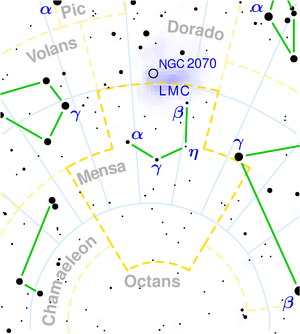|
|
Mensa ( Latin: table) is a southern constellation which was first introduced by Nicolas Louis de Lacaille under the name Mons Mensae (Latin for table mountain). This specifically refers to Table Mountain in South Africa, where Lacaille made important early observations of the southern sky. It contains no bright stars, with Alpha Mensae its brightest star at a barely visible magnitude 5.09, making it the faintest constellation in the entire sky, but it does contain part of the Large Magellanic Cloud (the rest being in Dorado). The constellation covers a keystone-shaped wedge of sky stretching from approximately 4h to 7.5h of right ascension, and −71 to −85.5 degrees of declination. Other than the south polar constellation of Octans, it is the most southerly of constellations. As a result, it is essentially unobservable from the Northern Hemisphere. Besides those already mentioned, its other neighbouring constellations are Chamaeleon, Hydrus and Volans. The first images taken by the Chandra X-Ray Observatory were of PKS 0637-752, a quasar in Mensa with a large gas jet visible in both optical and x-ray wavelengths. Notable features Alpha Mensae is a solar-type star (class G5 V) 33 light-years from Earth, and is considered a good prospect for harboring an Earth-like planet. Pi Mensae, on the other hand, while also solar-type (G1) and at 59 light-years, has been found to have a large gas giant in an eccentric orbit crossing the habitable zone, which would effectively rule out the existence of any habitable planets. History Since Mensa was introduced in the 18th century, and lies close to the south celestial pole, it was not known to classical or early cultures, and so they produced no mythology concerning it. References * Ian Ridpath and Wil Tirion (2007). Stars and Planets Guide Links
Retrieved from "http://en.wikipedia.org/"
|
|
||||||||||||||||||||||||||||||||||||||||||||||||||||
